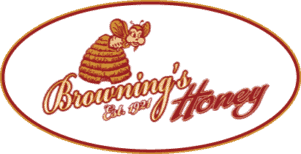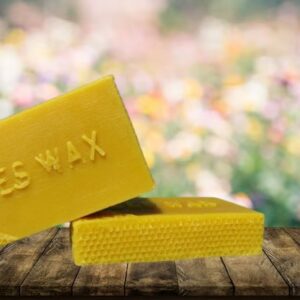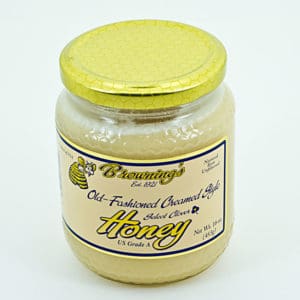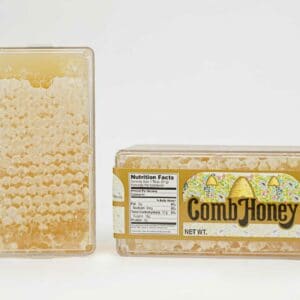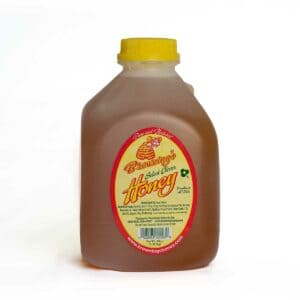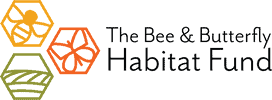Home » The Buzz Blog » National Honey Month: How to Support the Bees
National Honey Month: How to Support the Bees
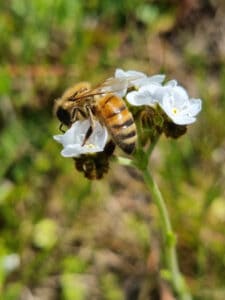
Honey Bees are an integral part of our agricultural systems, and in recent years their health and numbers have declined. A world without bees is alarming since they are crucial for pollinating many of our food crops, which account for about one-third of our diet.
At Browning’s Honey, we love honey bees and enjoy considering how each of us can make small contributions that add up to a significant positive effect on them and all pollinators.
As we celebrate the National Honey Month, learn how to support the honey bees with these simple steps.
Responsible use of Pesticides
This seems like a pretty obvious approach for growers to aid bees, isn’t it? It’s not always that simple, of course. Sometimes you must come up with a solution to deal with a cabbage worm or Japanese beetle infestation.
Choose plants from local nurseries. Avoid seeds treated with systemic pesticides, like neonicotinoids, and address these pest problems where and when they occur rather than spraying broad-spectrum pesticides in discriminant.
Choose Organic
Honey bees are generalist pollinators that visit blossoms from many plants, trees, and shrubs over a very large area. Often honey bees will fly over 2 miles from their hive to find the best blossoms. It is crucial that blooms are not coated with toxins that could harm the hive because honey bees cannot discern which crops in an area have been treated and which ones have not. Nowadays, many small-scale farmers use organic or permaculture farming methods on their farms. This entails farming without the use of pesticides and growing multiple crops as opposed to a single crop. For bees, that would be great news.
To be sure the products you buy are bee-friendly, look for labels that state “grown without pesticides” at your neighborhood supermarket or go to your neighborhood farmer’s market. Here you can find some great organic pesticides. An excellent method to help the bees and your neighborhood is to buy organic and locally.
Grow Bee-Friendly Flowers and Plants
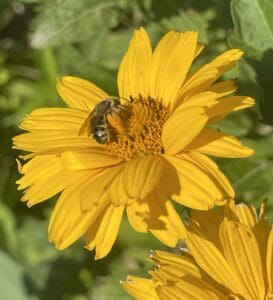
Anyone can plant a bee-friendly garden, regardless of whether they raise bees or not.
Include some native plants from your area in a range of vibrant colors when choosing your garden blossoms. Like people, bees value variety. Plant flowers in bunches and with blossoms of various sizes and shapes to make foraging easier. Explore plants that bloom throughout the year. Support a variety of pollinators throughout a variety of seasons. Smaller plants produce forage more frequently, but trees and shrubs produce significantly larger amounts of pollen and nectar, so it’s great to have a variety of both. For landowners with large areas, consider enrolling a portion of your land in to pollinator focused conservation program. Browning’s Honey Co., is a co-founder of the Bee and Butterfly Habitat Fund. A non-profit organization that provides seeds and professional support to landowners who are able to establish pollinator habitat on projects of 2 acres and larger in size. The BBHF “Next Gen Habitat” is an amazing, beautiful habitat for pollinators! Find out more at www.beeandbutterflyfund.org.
Create A Pollinator Space
A pollinator garden can be very beneficial to honeybees. honey bees can starve if neighboring flowers aren’t abundant with honey and pollen, which they need to survive. Make sure your garden is pesticide-free before you grow a pollinator garden to give bees a year-round food source.
Pollinators need water too!
Honey bees require access to water. It’s a good idea to give them a water source because they frequently drown in pet bowls or swimming pools, which don’t have the best water quality for honey bees. When given an option, honey bees prefer unclean, algae covered water. In the sweltering summer, builder a bee pond or bee bath with barriers like pebbles or sticks for honey bees to land on to prevent honey bees from drowning.
Let the grass grow a little!
Less frequent grass cutting provides pollinators with refuge and food sources. If you have a lawn, let some of it grow longer and mow less frequently to give your mower (and back) a break. Dandelions and especially clover are a great food source for pollinators.
Native Pollinators need nesting habitat.
The majority of native bee species are solitary, with the exception of domestic honey bees and native bumble bees, which live in social colonies. In other words, they don’t contribute to the care of their young or make honey. The eggs of solitary bee species are instead laid in a number of chambers within a nesting tunnel. 70% of the solitary nesting bees that are native deposit their eggs in underground tunnels. The remaining 30% of solitary bees lay their eggs in hollowed out plant stems, tunnels in dead trees, or downed logs. As crucial as supplying native plants to supply them with pollen and nectar are nesting areas for native bees. Keep dead trees or fallen logs, allow bare patches of soil in your yard for ground nesting bees, and leave plant stems hanging throughout winter. In order to give native bees a place to breed, you can also build native bee nesting houses.
Don’t be afraid!
Don’t be frightened of pollinators on your property unless you have a specific bee allergy. Yellow jackets, wasps, and hornets, which are sometimes referred to as “bees” are not at all. They are carnivores, they won’t be drawn to your pollinator space.
Buy Local Honey
You can help your neighborhood beekeepers and their bees, as well as your own health and the environmental well-being of your town or city, by buying raw local honey. Raw honey is obtained directly from the hive without over-pasteurization or ultra-filtering to preserves all of its antioxidants, vitamins, minerals, and flavor.
Additionally, raw honey is widely recognized as treatment small burns and abrasions as well as colds and flu. You can keep yourself and your neighborhood healthy by only purchasing locally produced raw honey.
Beneficial Insects Are Great In Your Garden
Treat beneficial insects like hoverflies, beetles, and ladybirds as allies rather than foes because they hunt pest insects like aphids. We can support bees and other members of nature while maintaining beautiful gardens.
Your patch will be transformed, pests will be naturally controlled, and your plants and crops will receive free pollination if you let bees be your guide and ally. That is not a fair trade at all.
Educate Your Children About Bees
Children can become more environmentally conscious and be motivated to spend time outside and away from screens by learning about bees and other pollinators. Bees are intriguing, too!
One-third of our food crops and 90% of our wild plants depend on pollinators, so if you have a vegetable garden, this might be a great approach to discuss their significance.
Get Involved
Honeybee ecologists and researchers are beginning to ask the public for assistance in large-scale research projects. You may provide crucial data to these initiatives, all of which advance our understanding of what we can do to assist the honey bee in need. Check them out and get involved!
We hope that these recommendations may help you to save the bees.
We look forward to seeing all of you playing a significant role in finding a solution, standing up for bees, and perhaps even becoming bee-safe partners!
Check out our shop where we are donating 5% of all purchases this month to Saving the Bees.
-
Creamed Style Honey
16oz Gift Jar Old-fashioned Creamed Style Honey
Rated 0 out of 5$11.49 Add to cart
